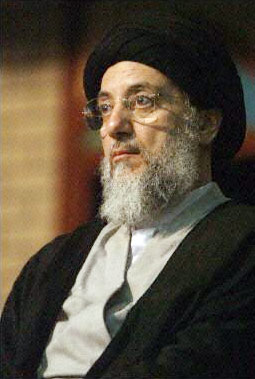Mohammad Baqir al-Hakim facts for kids
Quick facts for kids
Muhammad Baqir al-Hakim
محمد باقر الحكيم |
|
|---|---|
 |
|
| Born | 8 July 1939 Najaf, Kingdom of Iraq
|
| Died | 29 August 2003 (aged 64) Najaf, Coalition-occupied Iraq
|
| Political party | Supreme Council for Islamic Revolution in Iraq |
| Parent(s) |
|
| Family | Hakim family |
Ayatollah al-Sayyid Muhammad Baqir al-Hakim (born July 8, 1939 – died August 29, 2003) was an important Shia Islamic scholar and leader from Iraq. People also knew him as Shaheed al-Mehraab. He led a group called the Supreme Council for Islamic Revolution in Iraq (SCIRI).
Al-Hakim lived outside Iraq, in Iran, for over 20 years. He came back to Iraq in May 2003 after the US-led invasion. He was a well-known figure, similar to Ayatollah Khomeini in Iran. After returning to Iraq, his life was in danger. This was because he encouraged Shia people to stand up against Saddam Hussein. He was killed in 2003 after leaving a holy shrine.
Contents
About Muhammad Baqir al-Hakim
His Early Life
Muhammad Baqir al-Hakim was born in Najaf, Iraq, in 1939. He came from the Hakim Family, which was famous for its religious scholars. His father, Muhsin al-Hakim, was a very respected religious leader in Najaf.
Muhammad Baqir al-Hakim received traditional training to become a Shia imam. In 1972, the government at the time, known as the Ba'athist government, arrested him for his beliefs. He later had to leave Iraq and went to Iran in 1980. Many of his family members were killed by the Ba'athist government.
Working for Change in Iraq
Al-Hakim became the head of the Supreme Council of the Revolution in Iraq (SCIRI). This group was very important among the Shia community in Iraq. He helped start the modern Islamic political movement in Iraq in the 1960s. He worked closely with Mohammad Baqir al-Sadr until al-Sadr's death in 1980.
Once, Mohammad Baqir al-Sadr sent Al-Hakim to help calm people caught between government troops. This event led to Al-Hakim's arrest and imprisonment by the Ba'athist government. Even when Mohammad Baqir al-Sadr was under house arrest, he stayed in touch with Al-Hakim.
The ruling Ba'ath Party saw Al-Hakim as a threat. This was mainly because he spoke up for Iraq's Shia population, who were the majority. The ruling government was mostly Sunni.
Al-Hakim was released from prison in July 1979. However, a war started between Iraq and Iran, which was mostly Shia. This made the Ba'ath party trust the Shia people in Iraq even less. Because of this, and his past arrests, Al-Hakim went to Iran in 1980.
SCIRI and His Time in Iran
While safe in Iran, Al-Hakim became a strong opponent of the Ba'athist government. He created the Supreme Council for the Islamic Revolution in Iraq (SCIRI). This group wanted to remove Saddam Hussein from power and set up a religious government. With help from Iran, SCIRI became an armed group. They would sometimes launch attacks across the border into Iraq. They also kept secret connections with people resisting the government inside Iraq.
The Badr Brigades
The Badr Brigades were the military part of SCIRI until 2003. Al-Hakim formed these brigades to fight against Saddam Hussein. They had about 10,000 trained soldiers. In 1995, the Badr Brigades attacked Iraqi government forces in Amarah. Later, during the War in Iraq (2013–17), the Badr Brigades fought against ISIL as part of the Popular Mobilization Forces.
Coming Back to Iraq
Al-Hakim returned to Iraq on May 12, 2003. This was after Saddam's government was overthrown by the U.S.-led invasion. He had been in exile for over two decades. When he came back, he became one of the most important leaders in Iraq. His long history of opposing Saddam gave him a lot of respect, especially among the Shia majority.
At first, he was critical of the U.S.-led invasion. But Al-Hakim later gave the U.S. credit for removing Saddam's government. This allowed SCIRI and other Shia groups to rebuild their connections with the Shia people. Al-Hakim's brother, Abdul Aziz al-Hakim, was chosen to be part of the Iraq interim governing council. The two brothers worked closely together. By the time he died, Al-Hakim still had some doubts, but he publicly asked Iraqis to avoid violence. He urged them to give the temporary government a chance to earn their trust.
His Death
Al-Hakim was killed on August 29, 2003. A car bomb exploded as he was leaving the Shrine of Imam Ali in Najaf. This event is known as the
.
His Funeral
Hundreds of thousands of people attended his funeral in Najaf on September 2, 2003. They showed their anger towards the US military presence and demanded that US forces leave Iraq.
Later, during the 2019 Iraqi protests, his grave was attacked with petrol bombs by anti-government protesters.
See also
- Ayatollah Ruhollah Khomeini
- Ayatollah Ali Khamenei
- Ayatollah Mohammad Hussein Fadlallah
- Ayatollah Muhammad Baqir al-Sadr

